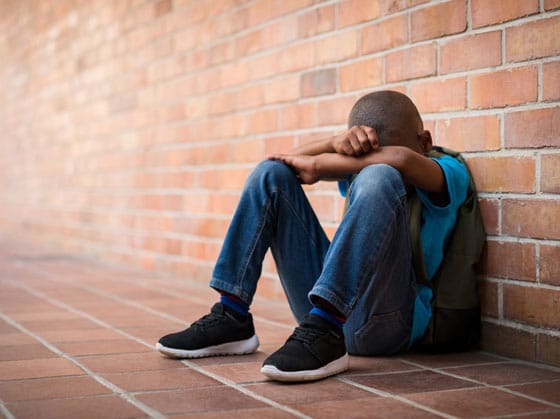Suicide crisis among Black youth
- February 12, 2020
- The REACH Institute
- Child mental health, Culturally responsive Suicide,

As suicidality among adolescents generally has declined in the past three decades, suicide attempts among Black adolescents have risen, according to a November 2019 article in Pediatrics. (See Resources below for links to the studies cited.) A report to the Congressional Black Caucus (CBC) says that rates of suicide death have risen more for Black youth than for any other racial or ethnic group.
A growing concern is that Black youth are less likely to report suicidal thoughts but more likely to attempt suicide; Black males are more likely to suffer injury or death as a result. Suicidality is also increasing among younger children.
The reasons for these changes are not clear. However, the risk factors for suicidality and underlying mental health conditions among Black children and youth are myriad.
The stress caused by systemic and interpersonal racism is an obvious culprit. According to REACH faculty member Diane Bloomfield, MD, of Montefiore Medical Center in the Bronx, New York, “We have to be aware of the macro- and microaggressions African American children experience. If not, we won’t be sensitive to the full range of mental health challenges they face.”
Other widely cited risk factors include poverty, family impairment, trauma and adverse childhood experiences, LGBTQ or same-gender loving identity, and lack of access to or use of mental health care. As Dr. Bloomfield pointed out, “It’s important to acknowledge the social determinants of health. Anyone who lives below the poverty line faces stress.
“However, many families are resilient in the face of these challenges,” she went on to say.
“We need to highlight what is working for them and help them build on these strengths.”
Protective factors, according to the CBC report, are a healthy family, religious or spiritual connections, community support, stable housing and income, and the child’s own assets, such as self-esteem and emotional well-being.
Systemic problems require systemic solutions. The articles and reports Dr. Bloomfield recommends (see Resources) suggest interventions by governments and health care systems ranging from targeted research to training for providers in culturally competent care.
But what can individual primary care providers (PCPs) do to reduce the risk of suicidal behavior among their own Black patients?
First, said Dr. Bloomfield, “Reduce the stigma of mental health for all children,” starting with universal screening.
“All pediatric PCPs should screen all patients all the time,” she said. “The screening tool helps you start a dialogue. If you ask patients how they feel, they might say, ‘I’m OK.’ Then you give them the screener, and they circle items that indicate they are not OK. It’s like they can’t lie to the paper!”
After screening, said Dr. Bloomfield, the next step is to “destigmatize the need to talk to someone. Tell them that depression is universal, that 13 percent of adolescents have had at least one major depressive episode, and that suicidal thoughts are common.” The stigma associated with mental illness is particularly strong in some Black communities, so PCPs need to work to overcome this negative association.
“When patients are ready to address the issues,” noted Dr. Bloomfield, “the challenge is getting them the care they need.”
She pointed out that PCPs are in a unique position to help: “Patients are more comfortable in their primary medical home. They don’t have to go down the street and tell the story again to someone else.” When mental health specialty care is out of reach or families are not likely to use what is available, REACH alumni can use the skills and tools from their training to treat patients who are at risk of suicide.
“I’d also advocate for shorter wait lists for families who don’t have good insurance and for mental health interventions in schools,” said Dr. Bloomfield. In addition to raising their own awareness of the specific mental health challenges faced by young people of color, PCPs can advocate at the local and national levels for policies to improve access to mental health care and to address the systemic issues underlying the rising rate of suicidality among Black youth.
RESOURCES
Alegria M, Vallas M, Pumariega A. Racial and ethnic disparities in pediatric mental health. Child Adolesc Psychiatr Clin N Am. 2010 Oct; 19(4): 759-774. doi:10.1016/j.chc.2010.07.001.
Discussion of differences between white and minority families in access to and use of mental health care leads to a wide-ranging set of recommendations to address the discrepancies.
Congressional Black Caucus Emergency Task Force on Black Youth Suicide and Mental Health. Ring the alarm: The crisis of Black youth suicide in the U.S. 2019. https://watsoncoleman.house.gov/uploadedfiles/full_taskforce_report.pdf. Published December 17, 2019. Accessed February 5, 2020.
This report outlines the problem and its causes, recommends policy interventions, and offers a substantial list of resources for professionals and families.
Lindsey MA, Sheftall AH, Xiao Y, Joe S. Trends of suicidal behaviors among high school students in the United States: 1991–2017. Pediatrics. 2019 Nov; 144(5): e20191187. doi:10.1542/peds.2019-1187.
Data from nearly 200,000 high school students reveal an increase in self-reported suicide attempts among Black male and female students since 1991, along with other disturbing trends.
Trent M, Dooley DG, Dougé J. The impact of racism on child and adolescent health. Pediatrics. 2019 Aug; 144(2): e20191765. doi:10.1542/peds.2019-1765.
This policy statement from the American Academy of Pediatrics describes the role of racism in health outcomes for minority children and youth. It offers recommendations for clinical practice, professional education, advocacy, and research.
Categories
- ADHD
- Anti-racism
- Anxiety
- Assessment & screening
- Autism
- Child mental health
- Coding
- Cognitive behavioral therapy
- College transition
- Culturally responsive
- Depression
- Eating disorders
- Foster care
- Grief
- High-risk children & youth
- LGBTQIA
- Medication
- Parents
- Patient communication
- Pediatric primary care
- School refusal
- Sleep disorders
- Suicide
- Trauma
- Show All Categories
Register for courses
“REACH offered a safe environment to learn and share in It was, and continues to be, a supportive, invigorating process! It was motivating and has increased my confidence in assessment, diagnosis of mental health cases in my day to day life and practice.”
